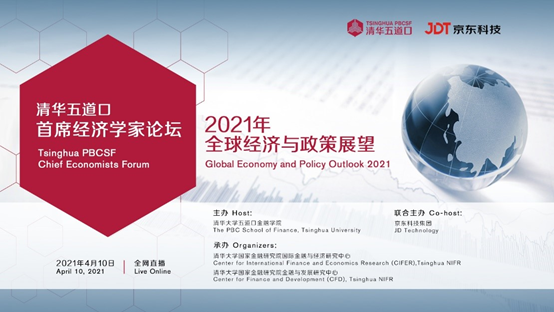
The Tsinghua PBCSF Chief Economists Forum, in its second year, was successfully held, on April 10, 2021.
The Tsinghua PBCSF Chief Economists Forum: Global Economy and Policy Outlook 2021 is hosted by PBC School of Finance, Tsinghua University (The PBCSF), co-sponsored by JD Technology Group, Center for International Finance and Economics Research (CIFER) of National Institute of Financial Research (NIFR), Tsinghua University, and Center for Finance and Development (CFD). The forum was live streamed on 27 online media platform, attracting nearly 100 media and over 3 million viewers.
This forum consists of two parts: keynote speeches and round table discussions. More than twenty distinguished guests were invited to join in-depth discussions on global economy outlook, China's macroeconomic and policy outlook, currency and credit in the post-epidemic era, carbon neutrality and macroeconomics.
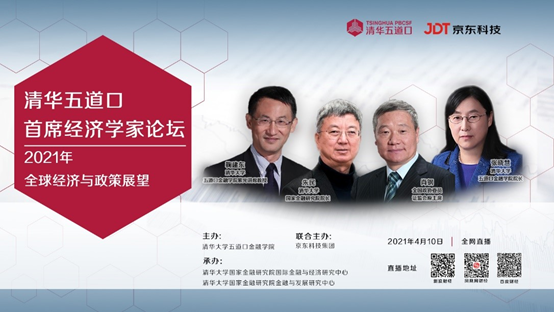
The Forum was presided over by Ju Jiandong, Unigroup Chair Professor of Finance at The PBCSF and Director of the CIFER.
Zhang Xiaohui, Dean of The PBCSF, delivered an opening speech. She said that 2021 marks the 110th anniversary of Tsinghua University and the 40th of Tsinghua PBCSF. This forum is held for academic debate at this historical time. The Forum’s topics focus on special concern at home and abroad. And she is looking forward to the valuable insights on the world economy and China's economy.
Xiao Gang, former chairman of the China Securities Regulatory Commission (CSRC), delivered a keynote speech on "The Causes and Responses to the Trend of Global Economic Diversification". He believes that the global economic differentiation is serious, especially in regional, industrial, and financial market. The causes of economic differentiation include the different modes of response to the pandemic in various countries, the effects of macro-stimulus policies, the growth of the digital economy, and the excessive gap between the rich and the poor. Xiao said that there are both global and regional causes to structural imbalance. It is necessary to adhere to supply-side structural reforms, strengthen demand-side management, and follow the laws of economic development.
Zhu Min, chair of NIFR, Tsinghua University, and former deputy managing director of the International Monetary Fund (IMF), said that macroeconomic policies in 2021 should promote growth and maintain balance, and repeatedly emphasized that structural and qualitative development is more important than quantity. According to Zhu Min, in 2020, governments were focusing on responding to the economic recession under the impact of the pandemic, and the policy goal was to promote the increase of economic aggregates. However, the pandemic and its consequences have caused structural imbalances in economic activities, as well as structural effect on the overall pattern of China's domestic economic growth. Rather than focusing on total volume, the policy in 2021 should pay attention to structural recovery. Three relatively strong factors are shown as follows. First, the speed of aging is much faster than expected, which will change demand, supply, and finance. Second, the goal of achieving carbon neutrality by 2060 is not only an energy revolution, but also a technological revolution. China is facing far more challenges in transition than Europe. Third, in digital transformation, turning digits into resources and assets will fundamentally change the country’s endowment and redefine the country’s core competitiveness. Based on the conditions, macroeconomic policy faces threefold tasks: repairing past imbalances, promoting economic growth, and integrating the foresighted structural optimization in economic growth. It is still very important to maintain liquidity at this stage, but the accuracy and intensity of the fiscal policy in 2021 is vital.
Discussions at Round Table (I): Global Economy Outlook
Shen Jianguang, chief economist of JD Technology Group, presided over the session. In Shen's opinion, the COVID-19 pandemic has triggered unprecedented policy stimuli. Although the new currency theory has been criticized by mainstream economics, fiscal deficits have been more or less put into practice in many countries. In the post-epidemic era, monetary policy is facing a dilemma. As global inflation expectations rises, the 10-year yield of the U.S. Treasury securities has risen rapidly, and the reversal of the US dollar has put pressure on exchange rates among emerging market. In 2021, the global economy will have to find a way to break through under the practice of the new currency theory.
Zhu Haibin, chief executive of JP Morgan Chase & Co., said that the global economy is expected to grow by 6.5% in 2021, and this value has been continuously adjusted till recently. This will be the strongest growth in the world since the 1980s, but the degree of recovery varies from country to country. China's V-shaped rebound took the lead in 2020. In 2021, China is expected to grow by 9.5%, and the growth gap with the United States may narrow from 6% to 3%. China’s strong quarter-on-quarter growth last year will return to 5-6 per cent this year. The leading role will possibly shift from China to the United States. The U.S is catching up after a new round of fiscal stimulus and the spread of vaccines, while it will take time for the remaining economies to fully recover.
Wang Qian, chief economist of Vanguard, believes that in the first half of 2021, the U.S. economy will thrive, with funds flowing from emerging markets to the U.S., while in the second half of the year, the U.S. dollar may weaken and funds will flow out. In the post-epidemic era, the characteristics of low growth, low interest rates, low inflation, low return on investment, and high uncertainty are very challenging for investors. Qian is not pessimistic about the performance of risk assets. However, certain regions and industries, including the United States, emerging markets, and Chinese stock markets, as well as growth stocks and large-cap stocks, are overvalued. Market volatility is high, and long-term investment returns are relatively low.
Ding Shuang, chief economist at Standard Chartered Bank China, holds the opinion that the global output gap is still relatively large and the possibility of sustained inflation may be small. He believes that the Federal Reserve will ignore the temporary rise in inflation, and interest rate hikes may not be implemented until the unemployment rate drops to about 3.5% in 2023.
Xing Ziqiang, chief economist of Morgan Stanley China, thinks that this round of inflationary pressures in the U.S. is extraordinary. The "high-pressure economy" that the U.S. is building aims to promote the full employment of middle-class and blue-collar workers. The U.S. not only pursues GDP growth to return to the pre-pandemic level, but also wants to benefit the low- and middle-income groups. But the inevitable side effect is inflation. If the U.S. economy overheats, inflation is likely to rise above 2.5% by the end of this year or early next year. In addition, three structural factors make the pressure of a comeback of U.S. inflation in the medium and long term not to be underestimated, because the three factors that have restrained inflation and increased productivity in the past 30 years are now beginning to reverse, including trade, tech and titans.
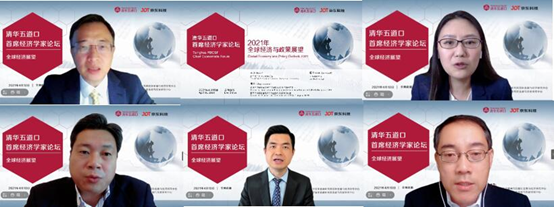
Group photo of guests attending Round Table (I) the Global Economy Outlook
Discussions at Round Table (II): China’s Macro-economy and Policy Outlook
The session was hosted by Wang Tao, chief economist of UBS Group China. He predicts that China's economy is expected to achieve 9% growth this year, driven by domestic consumption and exports. And manufacturing investment will also rebound significantly under the substantial increase in corporate income and orders. This year, China’s inflation is generally under control, and monetary and fiscal policies are gradually normalizing. It is expected that there will be a small interest rate hike in the third quarter, mainly in terms of credit policy tightening, and it is expected that social finance will grow by 11% throughout the year. As nominal GDP growth this year may be close to 12%, the annual macro leverage ratio can fall by 4-5 percentage points.
Cui Li, chief economist of China Construction Bank International, believes that the pandemic has accelerated the industrial transformation and upgrading of China's economy, and the potential growth rate may bottom out. It is highly possible that macro policies will be gradually tightening. Reflation will cause long-term interest rates to continue to rise, but policy interest rates may remain unchanged. Industrial policy will be a more important concern in the next few years.
Wu Ge, chief economist of Changjiang Securities, said that the pandemic has both the characteristics of demand shocks and supply shocks, and China is still making up the global supply and demand gap. Credit interest rates and mortgage interest rates will tend to rise, and inter-bank market interest rates are also likely to go up. The 10-year Treasury security interest rate is in line with the nominal GDP trend, and the upward momentum may be weaker in the second half of the year.
Guan Tao, global chief economist at BOC International, thinks that panic reduction in emerging markets is an important tail risk in the post-epidemic era, but China is in a favorable position in panic reduction. Because after the renminbi exchange rate breaks the mark of 7, the flexibility has greatly increased, and the independence of monetary policy has also risen significantly. However, China needs to have plans to deal with the spillover effects of panic reduction in other countries.
Zhang Zhiwei, chief economist of Pinpoint Asset Management, sees the year 2021 as a turning year from a policy perspective, and believes the deterministic risk is the upside risk. From an investment perspective, he thinks this year is the year to hold on to the results. Investors are more willing to invest in countries with more stable mid- and long-term policies. The current U.S. policy is harmful to its interests, focusing more on the short-term economy. China should consider the long-term and accelerate structural reforms.
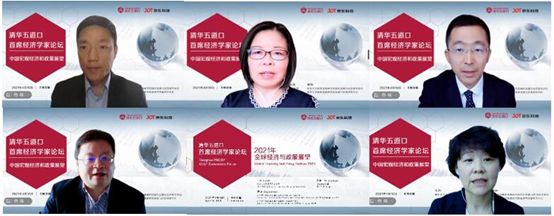
Group photo of guests attending Round Table (II) China Macro-economy and Policy Outlook
Discussions at Round Table (III): Currency and Credit in the Post-epidemic Era
Lu Ting, chief economist of Nomura Securities China presided the discussion. The session is in form of question and answer generally on issues of economic fundamental forecasts and monetary policy predictions; global, especially American economic policy expectations; and the impact of international markets on asset trends in China and emerging markets.
In regard to prediction of economic fundamentals, Guo Lei of GF Securities believes that the China’s net GDP growth rate this year is about 9-9.5%, and the nominal growth rate will reach 11-12%. Liang Zhonghua of Haitong Securities believes that the annual economic growth rate will be between 8-9%, and there will be downward pressure in the second half of the year. Song Xuetao of Tianfeng Securities predicts that this year's GDP growth rate is about 8.6%, and the nominal growth rate is 11.5%. The inflation is not of concern this year. Zhang Yu of Huachuang Securities said that this year’s GDP growth rate will be around 9%, inflation will hardly reach 3%, and the PPI will reach 5-6% in the middle of the year.
In terms of monetary policy, Guo Lei tends to think that interest rates will not be raised this year, but quantitative measures will be taken to promote contractionary monetary policy. As a result, credit and social financing are estimated to be relatively tight this year, and the growth rate of social financing may return to about 12%. Liang Zhonghua believes that the priority is to stabilize the currency and at the same time to tighten credit with targets. The annual growth rate of social financing may be around 11% or even lower. Song Xuetao predicts that there will be no interest rate hikes this year, but the tightening pressure will exceed 2018, and some credit risks must be prevented to a certain extent. Zhang Yu believes that this year's social financing growth rate is expected to be about 11.5-12%, but this year's credit tightening is unlikely to sharply repeat 2018.
Regarding the expectations of US economic policy, Zhang Yu believes that the Federal Reserve may reduce its easing at the end of this year and early next year, and the pressure on U.S. inflation in the next one or two years will be relatively high. Song Xuetao considers that in terms of employment and inflation, the Federal Reserve has been making marginal adjustments to the scale of unconventional currencies since last year. In terms of fiscal stimulus, the 1.9 trillion dollars of fiscal stimulus plan is excessive for the current needs of the U.S. economy, but this issue is a political consideration and is conducive to tax increases and infrastructure policies in the later period. Liang Zhonghua regards the economic recovery in the U.S. as the fastest in history. The 2008 economic crisis caused the United States to take about 4-5 years to recover, since the loss in both residents and corporate balance sheets. But it is different this time. Guo Lei thinks that the opportunity for herd immunity is an important watershed for U.S. monetary policy. In addition, according to data calculated by the U.S. Congressional Budget Office, the output gap can be closed in the first half of 2022; monetary policy exit strategy should be further implemented.
Regarding the impact of the international situation on the economy and asset trends, Liang Zhonghua believes that the theme of this year is "reversal", and the exchange rate is mainly reflected in the narrowing of the China-U.S. interest rate differential and the devaluation pressure of renminbi. Guo Lei thinks that this year is China's export year. After the pandemic, the global economy is recovering and supply constraints are gradually loosened. Renminbi will show typical two-way fluctuations this year. Zhang Yu supposes that exports can reach 8% this year, and there will be no sudden drop. China and the United States have entered a small economic and currency dual-cycle divergence and there will be a certain devaluation pressure on renminbi, but it won’t be high. Song Xuetao considers that China’s exports this year may be 10% year-on-year, and in the long run, there is still room for appreciation of renminbi.
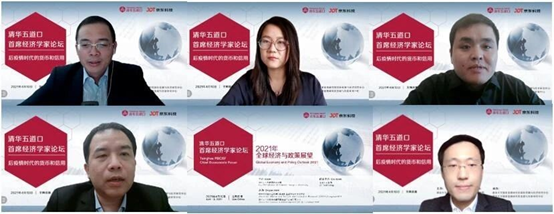
Round Table (III) Currency and Credit in the Post-pandemic Era
Discussion Topic of Round Table (IV): Carbon Neutrality and Macroeconomics
Ma Jun, Dean of the Beijing Institute of Finance and Sustainability presided over the discussion.
Huang Haizhou, Managing Director of CICC, believes that China is facing huge challenges, while there are still competitive advantages in achieving carbon neutrality. China’s annual emissions is the largest in the world, but investment will bring technological progress. As a large country of manufacture and digital economy, China should use electrification + clean electricity as the major solution of carbon neutrality, and explore effects of economies of scale brought by the clean energy. Provided transformation going well, the unit cost of energy will fall; but if the investment is not done appropriately with low efficiency, it may cause inflation. The systemic risks brought by global warming have a huge impact on the global economy, which require international coordination and cooperation.
Sun Mingchun, chief economist of Haitong International, believes that on the basis of achieving carbon neutrality at the operational level, financial institutions can also play their special roles as financial intermediaries. By practicing sustainable finance and impact investment, they can provide stronger incentives and constraints to carbon neutralization practices in other industries through market-based means, and help the entire society to achieve carbon neutrality as soon as possible. This includes achieving carbon neutrality at the financial institutions' own operational level, holdings of assets, and financing levels. Sun thinks that the early stage of the carbon-neutral transformation may have an adverse effect on economic growth and inflation, but it will be a big opportunity in the later stage. Compared with the possible catastrophic effects of climate change, the pains of transition are negligible, and the entire population needs to be made aware of the effects of climate change on the economy. In order to avoid excessively high transformation cost burdens on some industries, a carbon tax policy should be adopted on the final consumption side.
Chang Jian, chief economist of Barclays China, shared the research framework and the specific technical path of how American and European companies can achieve carbon neutrality, emphasizing that digitalization is an important measure. Chang believes that China is facing a short transition period and high pressure to achieve carbon neutrality. Low-carbon transition will bring cost-driven shocks, and monetary policy will be caught in a dilemma (inflation negatively correlates with yield).
Lu Zhengwei, chief economist of Industrial Bank, considers that actively promoting "carbon neutrality" will help China seize the historic opportunity of a new round of industrial revolution. The demand caused by “carbon neutrality” can stimulate the global economy to get out of the trap of “insufficient aggregate demand”. Different carbon neutral policies have different effects on the economy.
Ma Jun made the summary that: 1. at the macroeconomic level, a relatively high-quality analytical framework is needed to study the impact of carbon neutrality on the macroeconomic. This framework should be a dynamic, cross-cycle model that integrates climate and energy model into one macroeconomic model. 2. a thorough study should be conducted on the investment opportunities and challenges brought about by carbon neutrality. The main challenge is the impact of high-carbon industries on financial stability, which requires more quantitative analysis. Not only financial institutions, but the central bank, as the authority in charge of financial stability, should also be analyzed. 3. carbon neutrality will bring about an unbalanced distribution of the cost of income, including distribution between regions and industries. Under certain circumstances, it may lead to substantial contraction of certain economies and industries that further leads to unemployment. How to ensure a fair transformation so that social stability does not suffer is also a topic that needs to be studied.
The 2021 Tsinghua PBCSF Chief Economist Forum concluded, attracting wide social attention and media reports. The Forum is dedicated to focusing on global issues, encouraging multi-dimensional studies, and promoting the exchanges of policy, marketing, and academic research.